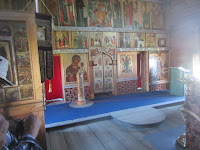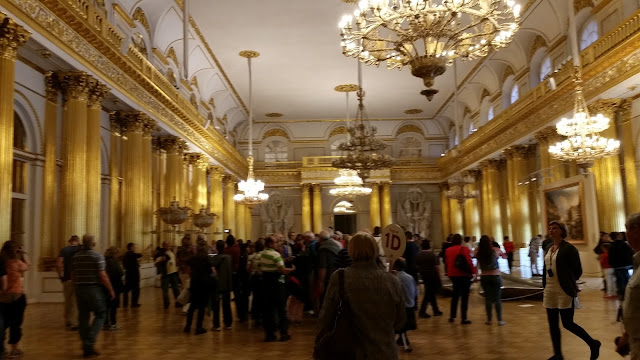As we walked out from beneath the trees that border the lake the first thing we saw was the Church of Transfiguration. Around this church with its twenty-two onion shaped domes was a high wall. As we walked toward it I could hear a voice in my ear. (When we were touring a site with a guide she would transmit commentary to the small radio receivers we carried.) It was kind of like that little voice Magnum, P.I. heard, but not quite. She was telling us why the church looked so strange. And indeed, it did look strange! That is if you can imagine a multi-level octagonal structure topped with domes appearing stranger than usual. What she was referring to was the fact that you could see
through the midsection of the church. That was strange. The church was undergoing restoration. In doing so the conservators had built a steel frame inside the church to support it during restoration. This steel skeleton was visible where the midsection of the building was missing. As we entered through the gate in the surrounding wall we got a closeup view of the church. I'm always fascinated by construction methods. The church is built of wood, scots pine logs actually. The notched logs are joined at the corners. There are eight corners in an octagonal building. However, the logs are joined in a crude tongue and groove fashion. This eliminates a gap between the logs. There was no "chinking" (mud between the logs) you see in American pioneer cabins. No nails are used in the construction of this 37 meter tall structure. And the seventeenth century builder used only an axe. Folklore says that when he finished the church he threw his axe into the lake, proclaiming that he could never build a more beautiful church. Next to it is a bell tower which is almost as tall. The Church of Transfiguration may be the tallest wooden church in the world.
Next we visited a typical house of 17th century Russia. It was a log house in a rectangular shape. The second floor was for people while the lower floor was for storage and animals in the winter. The living area was dominated by a huge ceramic stove. It was used for cooking as well as providing
heat. An interesting feature was the bed on the top of the stove for the elderly and children to sleep in during the cold Russian winters. Furniture was simple but functional and there was a lady in peasant dress making lace. She had samples of her work for sale for a few rubles. Next to the living area for people was a huge loft with a ramp to allow livestock access.
There were several other structures on the tiny island in Lake Onega. There was a sauna bathhouse, a wind powered mill, and another church. We saw a woman tending her vegetable garden near the bathhouse and a man making roofing shingles in the shade of a huge tree. He was fashioning the shingles from birch wood with a hatchet. It was similar to a teardrop shape like those covering the domes of the churches. I recalled how shingles were made by my great uncle with mallet and fro. He could make a half dozen cedar shingles in a minute. This Russian craftsman could make one in about half an hour, but his were pretty.
The last place we visited at Kizhi was the Church of Intercession. It was less grand than the Church of Transfiguration, with only nine domes, but was accessible. The interior had icons on all walls. These are of the Byzantine style, showing biblical characters with elongated faces and bodies.
Russian Orthodox religion is similar to the Greek Orthodox faith. The main room is divided and only men are allowed behind the second wall. Women must cover their heads when entering the Russian Orthodox church. The rooms had high ceilings and a number of monks serenaded us with a cappella singing. It was beautiful, although I understood not a word.
There was a leisurely walk back to the ship. Upon leaving we felt we had seen a bit of Russian history. After all the palaces in Saint Petersburg it was good to see how the lower classes lived. That night we dined with Eli and Nina. The retired couple was from San Francisco but had seen much of the world. He was a big man in his late seventies with thinning gray hair and a slight aquiline nose. He spoke in a low tone modulating each word that rolled off his tongue. Eli had previously owned a manufacturing company and was most interesting in discussing the United States policy toward Israel. The former businessman was from Israel and I believe he had relatives there. He told how the Israelis had built a hospital near its borders, which served the wounded children from either side. Nina, who was perhaps a bit younger but had added significant pounds during the aging process, spoke in accented English. She wore her make-up well with what I would consider "ultra red" lipstick. Born in the Ukraine, she had immigrated Israel and then to the Unite States as a young woman. She, like her husband, was very pro-Israel. They were delightful conversationalists and we enjoyed our evening meal with them very much.
There was hardly a hint of movement as the Ingvar sailed across Lake Onega. Kizhi











